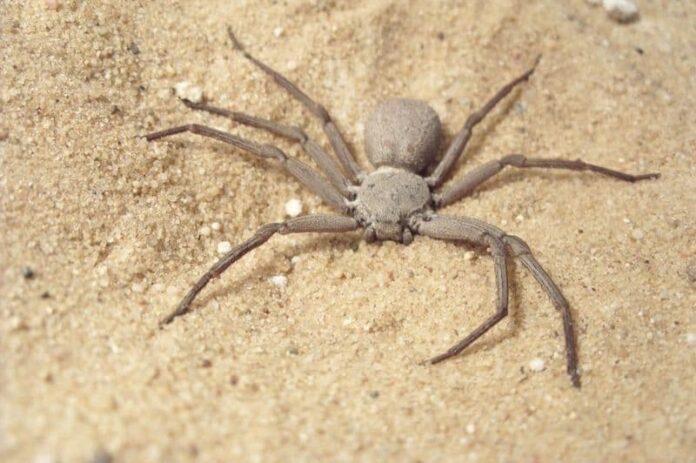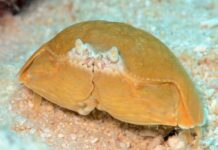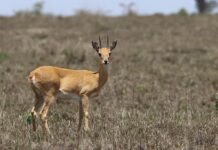Spiders are everywhere, aren’t they? We are taking a different approach today, talking about venomous desert spiders that can tolerate harsh living conditions. These desert spiders can live in high temperatures and low food availability with a limited number of shelter options. Some of them can be quite dangerous since they are venomous, and they seek shelter from your boots. Let’s take a look and see what those creepy crawlies are with me below.
1Carolina Wolf Spider
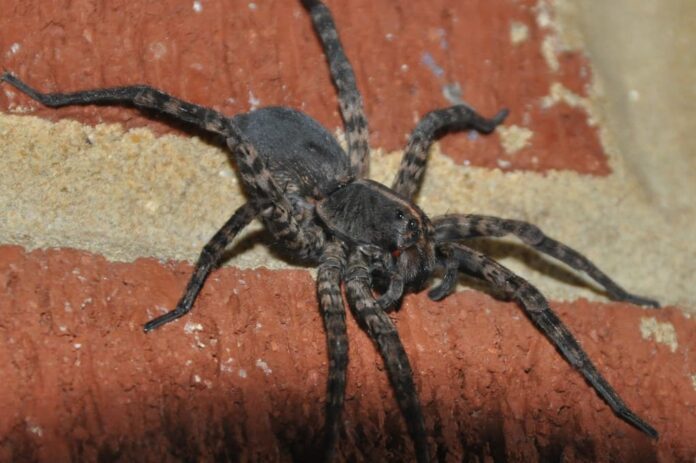
Being the largest wolf spider in North America, the California wolf spider also goes by the name giant wolf spider. They can grow up to 3 centimeters in length and 30 centimeters across. This arachnid is mottled brown in color with a darker black underside, and males have orange coloration on their sides. While you can recognize the males by the orange coloration, you can tell a female by the egg sac she carries. Female giant wolf spiders carry their egg sac on their backs wherever they go during incubation in the breeding season. Sometimes they can be mistaken for tarantulas due to their big size and hairy bodies.
When it comes to habitats, they prefer flatter and more open areas in many types of geography and topology. Apart from deserts, they also inhabit fields, grasslands, meadows, open areas, and pastures. As burrowing spiders, they live in either self-made burrows or the ones that they can find. And since they are burrowing spiders, they do not build a web to catch prey at all. However, they do spin a web to act as a mat that holds the burrow structure. These desert spiders hunt by ambushing their prey from the comfort of their burrows. They sit on the edge of their burrows or other good ambush locations and attack their prey when it gets near.
California wolf spiders are one of the venomous desert spiders that has a unique type of venom. Their venom can both paralyze their prey and prevent microbes from their prey infecting them. Speaking of prey, their most common meals are insects and small invertebrates such as crickets, grasshoppers, and more. Despite being venomous, they still fall prey to some predators in the wild. Some of the common ones are amphibians, coyotes, large arthropods, lizards, owls, scorpions, spider-eating birds, and wasps.
2Dancing White Lady
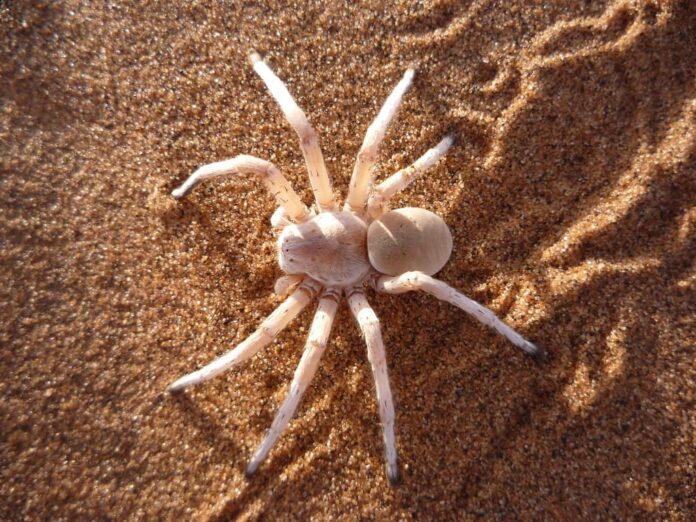
Despite having a pleasant name, the dancing white lady spider is a member of the huntsman spider family. A dancing white lady spider has a creamy white shading, and it got its name from their tap-dancing moves. This spider can grow up to 3.3 centimeters with a leg span of up to 14 centimeters. Their 8 eyes provide them with great night vision in different orientations to capture a panoramic view of their surroundings.
There are many fascinating facts about these venomous desert spiders that make them quite unique. Dancing white lady spiders communicate with each other by using seismic vibrations called drumming. Moreover, males will travel over 50 meters (which is a lot for a little spider) in one night to search for a mate. Males will venture into female territories and mat with up to 50% of the females they come across. During this journey, a male can encounter up to 5 other males that they will have to compete with.
Dancing white lady spiders primarily live in desert regions of Namibia, especially the dunes of the Namib Desert. Not different from other desert spiders, they live in burrows and hide in there to protect themselves from the heat during the day. When the night time comes, they wander to look for prey that ranges from arachnids and insects to reptiles. Some other common prey are beetles, lizards, moths, and weevils. In case food is scarce, they also resort to cannibalism; especially among males. Their venom is only deadly to their small prey but they do bite humans if they feel threatened. Though the venom is not lethal to humans, it still can cause discomfort and temporary swelling.
3Desert Blonde Tarantula
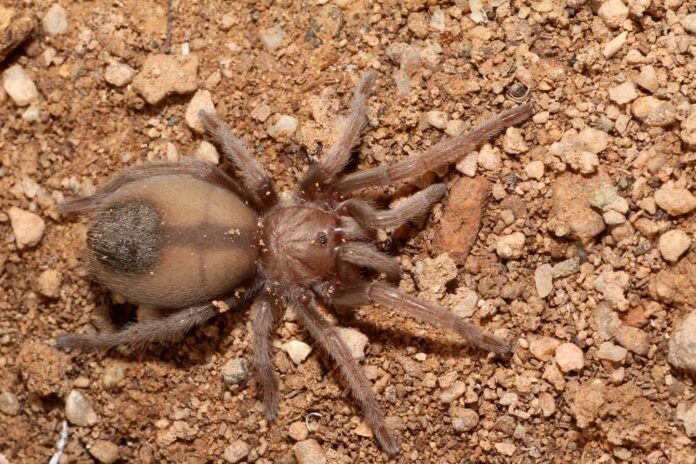
At a size of 8 to 13 centimeters, desert blonde tarantulas are something that you will not find hard to spot. A male desert blonde tarantula has a copper cephalothorax and reddish abdomen with black legs while a female is tan in color. More than that, males have longer legs than females, and there is a small hook on the back of their legs. They use this hook to hold the female during mating. Both sexes have a short coat of hairs on their bodies that they use as a defense. Desert blonde tarantulas have two sets of eyes, one is primary and another is secondary set.
Desert blonde tarantulas are very resistant to harsh weather, and they often live in burrows in desert soil. These spiders build their own burrows, usually very deep which allows them to adapt to the temperature fluctuation. They stay inside their burrows during the day and stay by the entrance at night waiting for prey. Their most common meals are invertebrates, and they have very little requirement for water. Desert blonde tarantulas never venture far from their burrows unless it is mating season. When winter comes, they plug their burrows with rocks, silk, and soil to keep warm when they are in an inactive state.
If we talk about the venom of these arachnids, it is very similar to the sting of a bee. Among the most venomous desert spiders, their venom is one of the least dangerous that you won’t have to worry about. This is also the reason why they are very popular as pets due to their docile nature and interesting appearance. However, what you have to watch out for is their urticating hairs that have backward pointing barbs on the tips. When threatened, they will brush these hairs into the face, paw, or other body parts of the intruder. These hairs can be difficult and irritating to remove so it is somehow quite painful.
4Desert Bush Spider
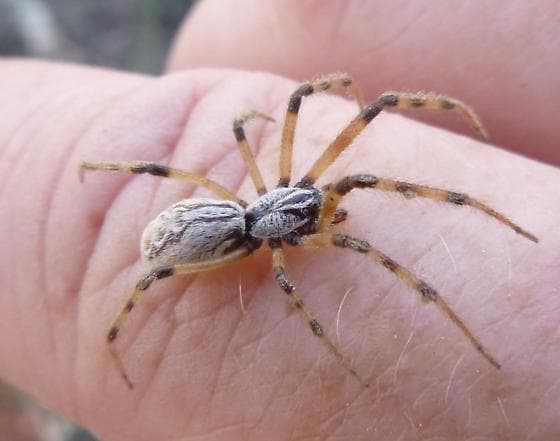
Desert bush spiders can grow up to 0.9 centimeters, and their orange-brown body is covered in short white hairs. They have dark brown abdomens with leaf-like markings that are white in color. Their legs are yellow-brown, and males and females have a similar appearance. Just like the name suggests, this spider species lives in desert and semidesert habitats in the United States. These spiders inhabit shrub adjacent to palm oasis where they construct their webs to catch prey.
While venom from many spiders can hurt or kill, the venom of the desert bush spiders is rather useful. Research into a toxin from this spider species can lead to new treatments for conditions like cardiac arrhythmia, epilepsy, and pain. More than that, it can even advance the development of eco-friendly insecticides.
5Desert Grass Spider
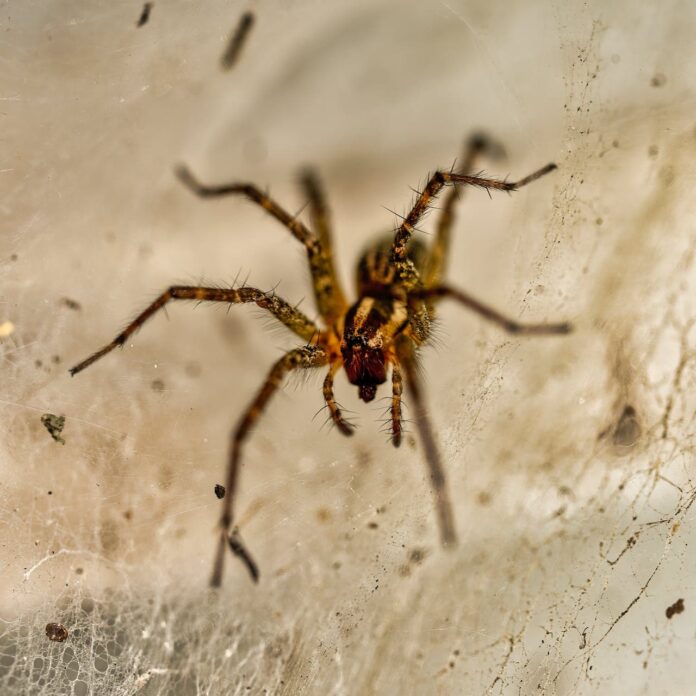
A desert grass spider is around 1.3 to 1.8 centimeters with relatively long legs to run after prey. It is black, brown, and gray in color, and it has a gray or tan cephalothorax with two longitudinal brown stripes. These spiders are monogamous, and they are quite territorial so fighting is also common as well. The fights for territory can result in injuries or predation, and it never ends well.
Just like other desert spiders, this one lives in arid and dry regions in parts of Mexico and the United States. Where they live, they construct funnel-shaped webs in crevices, and they wait in there for prey at night. Desert grass spiders’ favorite meals are usually insects such as aphids, grasshoppers, and other spiders. When one approaches, this spider will run after the prey with their long legs. Once it catches the prey, it injects its venom into the prey which results in rapid paralysis. The venom does not work the same with humans, so at least it is good to know.
6Deserta Grande Wolf Spider
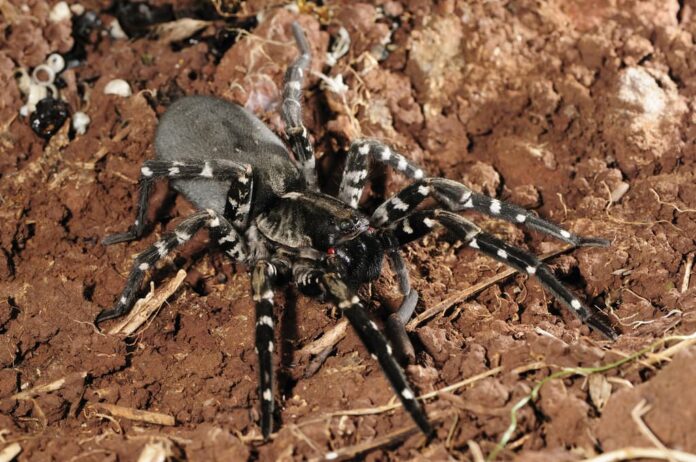
With a body size of 4 centimeters and a leg span of 12 centimeters, Deserta Grande wolf spider is one of the largest wolf spider species. In fact, it is the largest spider in Europe. A Deserta Grande wolf spider is black and gray in color, and it has white spots on its legs. Their most notable characteristics are definitely their eyes, 8 of them. Four are in the bottom row of their head, two on the above, and the top two are the largest. They have large fangs to deliver venom but their venom is not life-threatening to humans. A bite from one can only cause mild itching, pain, and swelling on the site.
Getting its name from where it comes from, this spider species is endemic to the Deserta Grande Island. Coming from only one specific region, it is not a doubt why it is also an endangered species. The estimation of their population is less than 5,000, and that makes it one of the rarest wolf spider species. During the daytime, they hide under crevices and rocks before coming out to hunt at night. Their prey includes beetles, millipedes, small lizards, woodlice, and other insects that they can find.
7Desert Recluse
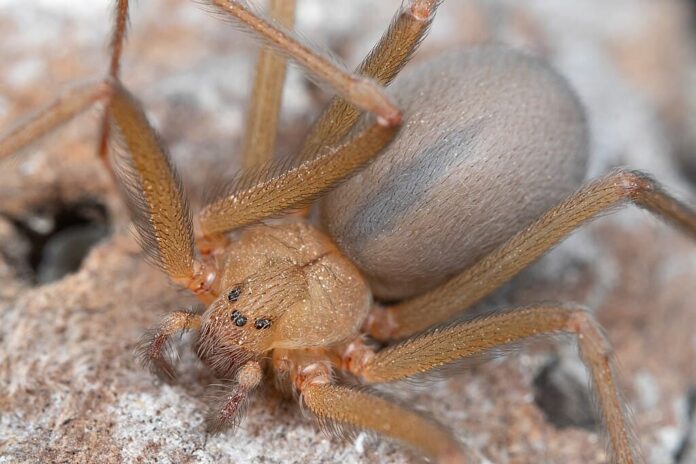
A desert recluse is brown to dark brown in color, and it has a dark violin-shaped pattern on the top of its cephalothorax. It has long hairless legs that spread at a length of around 4 centimeters. While most spiders have 8 eyes, this one only possesses 6 that are arranged in a wide arc across its head. Desert recluse spiders are in parts of Mexico and the United States where they dwell in the wild. Doesn’t matter where it comes from, a recluse spider is one of the most dangerous arachnids to avoid. One bite from it, and the victim will experience pain along with lesions of the skin. The only good thing is that the wound heals quickly without scarring in most victims.
8Desert Widow
Female desert widows are larger than males, growing to a size of 0.9 to 1.9 centimeters big. Meanwhile, the males are only 0.3 to 0.7 centimeters big. Females are very dark brown but they have light brown pigment with a pale golden hue when pregnant. As for males, they are brown with patterns on their abdomen that consist of various shades of brown.
Desert widow spiders are found in the arid deserts of Negev and the Arava Valley. They build webs with silk strands hanging from them to capture terrestrial insect prey at night. Usually, they make their large webs in bushes and other brush in large open areas of land. Some of the most common prey are ants, beetles, scorpions, and more. The venom from this spider species can cause latrodectism which includes muscle rigidity, pain, sweating, and vomiting.
9Six-Eyed Sand Spider
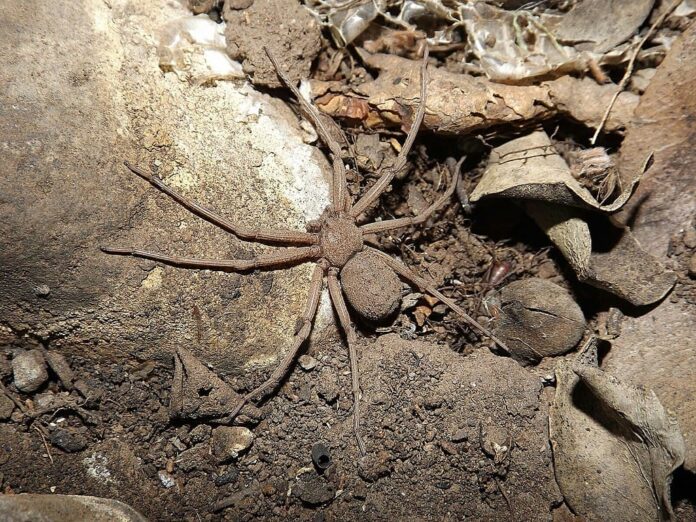
The six-eyed spiders also go by the name six-eyed crab spiders because of their flattened stance and elongated legs. A six-eyed spider has small hairs on its body that can hold sand particles to provide better camouflage. This spider can grow up to 1.5 centimeters in size with around 5 centimeters of leg span. It is reddish-brown to yellow in color, and the combination of their color and hair allows them to hide well. Unlike many other desert spiders, this one does not live in burrows. It simply buries itself under the surface of the sand or lives in caves, crevices, and natural debris.
As desert spiders, they hunt by ambushing their prey and they do not roam to search for prey at all. A six-eyed spider just lies in place and waits for an insect or scorpion to pass by. When that happens, it will seize the prey with its front legs and bite to inject venom before eating it. Another interesting thing is that these spiders do not need to feed very often so daily hunting is not necessary. More than that, adult six-eyed spiders can live without food or water for up to a year.
Now this is one of the most dangerous desert spiders that you should watch out for. The venom of spiders from the family Sicarius is in fact the most dangerous on record. The six-eyed spiders have dermonecrotic venom that can cause serious or even life-threatening wounds that spread and infect the body. It is so potent it can cause blood vessel leakage, necrotic lesions, and tissue destruction. The worst part? There is no antivenom exists for the bite of this spider yet. One of the only two unfortunate victims of this spider species lost his arm due to extensive tissue necrosis. While being secretive and shy, six-eyed spiders do not hesitate to bite even if it is an accidental contact.
10Wheel Spider
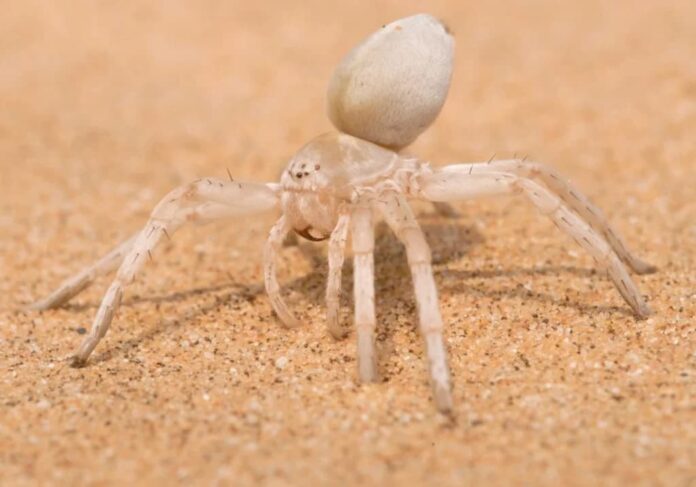
Here you are looking at the cousin of the dancing white lady spider that is also native to the Namib Desert. Where they live, the common habitats of these spiders are in steep sand dunes where they hide from predators and the sun. It is a small spider that grows to a size of 2 centimeters, and both males and females are the same size. These arachnids are elusive and nocturnal, and they spend most of their time burying in their burrows or hiding under rocks.
Wheel spiders or golden wheel spiders are cool spiders with the special ability to cartwheel down sand dunes. When escaping predators, they can flip onto their side and cartwheel at speeds of up to 44 turns per second. Their main predators are pompilid wasps, the type of wasp that stings and paralyzes them and then lays eggs in their bodies. These wasps can be quite scary as they can sniff the spider in its underground burrow. They can also plunge 50 centimeters below the surface of the sand dunes just to get the spider.
This spider species is one of the desert spiders with mild venom so they are not harmful to humans. Their venom is only strong enough to paralyze prey such as insects and other small invertebrates.
Related Post: Most Venomous Spiders In The World

